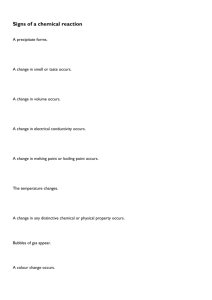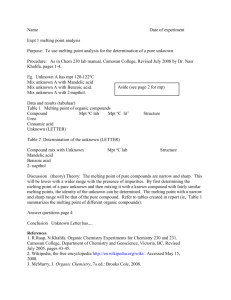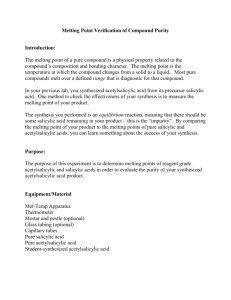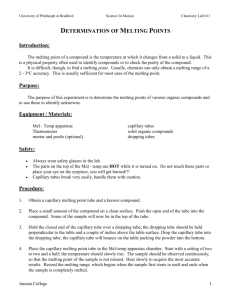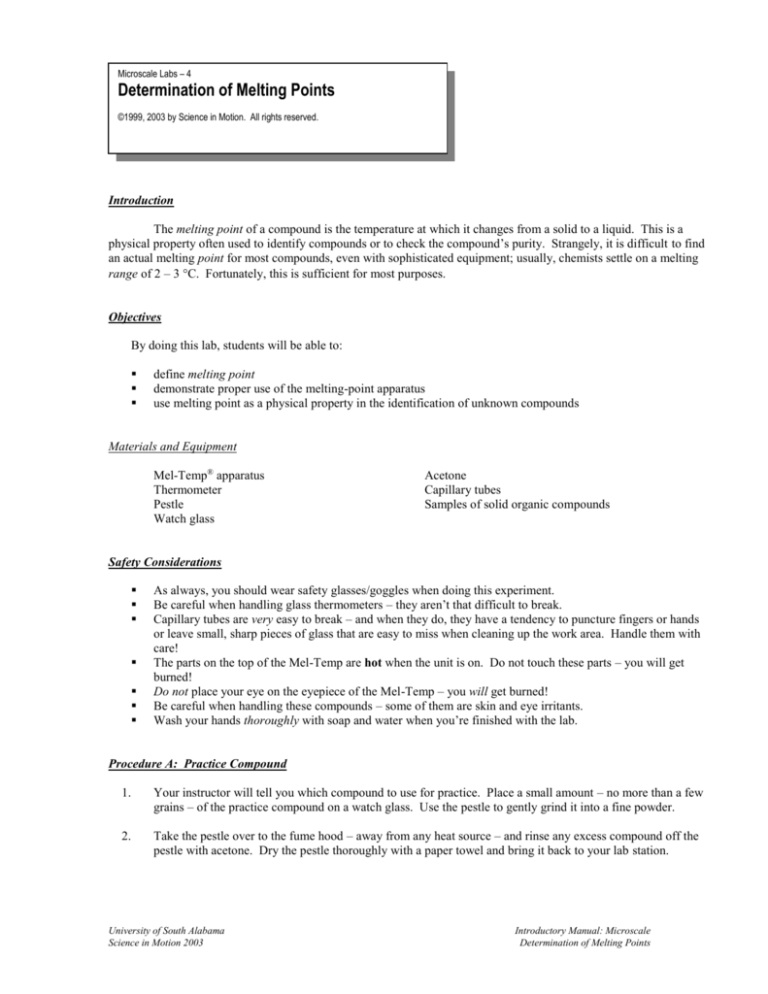
Microscale Labs – 4
Determination of Melting Points
©1999, 2003 by Science in Motion. All rights reserved.
Introduction
The melting point of a compound is the temperature at which it changes from a solid to a liquid. This is a
physical property often used to identify compounds or to check the compound’s purity. Strangely, it is difficult to find
an actual melting point for most compounds, even with sophisticated equipment; usually, chemists settle on a melting
range of 2 – 3 C. Fortunately, this is sufficient for most purposes.
Objectives
By doing this lab, students will be able to:
define melting point
demonstrate proper use of the melting-point apparatus
use melting point as a physical property in the identification of unknown compounds
Materials and Equipment
Mel-Temp® apparatus
Thermometer
Pestle
Watch glass
Acetone
Capillary tubes
Samples of solid organic compounds
Safety Considerations
As always, you should wear safety glasses/goggles when doing this experiment.
Be careful when handling glass thermometers – they aren’t that difficult to break.
Capillary tubes are very easy to break – and when they do, they have a tendency to puncture fingers or hands
or leave small, sharp pieces of glass that are easy to miss when cleaning up the work area. Handle them with
care!
The parts on the top of the Mel-Temp are hot when the unit is on. Do not touch these parts – you will get
burned!
Do not place your eye on the eyepiece of the Mel-Temp – you will get burned!
Be careful when handling these compounds – some of them are skin and eye irritants.
Wash your hands thoroughly with soap and water when you’re finished with the lab.
Procedure A: Practice Compound
1.
Your instructor will tell you which compound to use for practice. Place a small amount – no more than a few
grains – of the practice compound on a watch glass. Use the pestle to gently grind it into a fine powder.
2.
Take the pestle over to the fume hood – away from any heat source – and rinse any excess compound off the
pestle with acetone. Dry the pestle thoroughly with a paper towel and bring it back to your lab station.
University of South Alabama
Science in Motion 2003
Introductory Manual: Microscale
Determination of Melting Points
Microscale Lab 4 – Determination of Melting Points – 2
3.
Push the open end of the capillary tube into the compound on your watch glass. Some of the compound will
now be in the top of the tube. Gently tap the closed end of the tube on the bench top. This will pack the
compound down in the closed end of the tube. Repeat this a couple of times until you have about 0.5 cm of
the compound in the bottom of the tube (about half the width of your little finger, unless you have tiny
hands).
4.
Place the capillary tube in the chamber of the Mel-Temp apparatus and turn on the unit. Start with a setting
of 1 or 2 and increase the power only in small increments as needed, and never above 5. Heating your compound slowly is the key to getting good results!
5.
Observe the sample chamber frequently to make sure you don’t miss the melting point of your material. Heat
the compound slowly and record the temperatures at which the compound begins to melt and the temperature
when all of it has melted.
6.
Use the table on the data sheet to identify your practice compound.
Procedure B: Identifying an Unknown Compound
After everything has had a chance to cool down a bit, repeat the above procedure for an unknown compound.
Make sure you record which sample you have!
Disposal and Cleanup
Pour any excess compound left on your watch glass into the trash can. Take your watch glass over to the
vent hood and rinse off any remaining compound with acetone. Dry the glass thoroughly with a paper towel.
If you used a digital thermometer, make sure you turn it off before leaving the lab area. This helps prolong
the battery life (and these batteries are expensive).
Make sure the Mel-Temp apparatus is turned off before you leave the lab area.
Throw away any used capillary tubes.
Put everything where it was before you started the lab.
Wash your hands thoroughly with soap and water before leaving the lab area.
University of South Alabama
Science in Motion 2003
Introductory Manual: Microscale
Determination of Melting Points
NAME
Microscale Labs – 4
Determination of Melting Points
©1999, 2003 by Science in Motion. All rights reserved.
NAME
NAME
DATE
Compound
Acetylsalicylic acid
Benzoic acid
BHT (2, 6-di-t-butyl-4-methylphenol)
Citric acid
Ethyl p-aminobenzoate
Oxalic acid
Palmitic acid
Potassium iodide
Sodium chloride
Stearic acid
TOP (4-(t-octyl)phenol)
Urea
Vanillin
PERIOD
Melting Point / Range
135 – 136 C
122 C
69 – 71 C
153 C
88 – 90 C
101.5 C
61 – 64 C
680 C
804 C
71.2 C
79 – 82 C
132 C
81 – 83 C
Practice Compounds Data
Practice Compound
Observed Melting Range, C
Unknown Compound Data
Observed melting range
Identity of unknown compound
Questions
1. Define the “melting point” of a substance.
2. What is the purpose of determining melting points?
C
Microscale Lab 4 – Determination of Melting Points – 2
3. Why is this method not used for finding the melting points of inorganic compounds?
4. Why could the rate of heating influence the observed melting point?
5. The melting ranges of TOP (4-(t-octyl)phenol) and vanillin overlap. If you could narrow down your choices so that you knew
your unknown was one of these two compounds, how might you distinguish between the two?
University of South Alabama
Science in Motion 2003
Introductory Manual: Microscale
Determination of Melting Points



